2001 BMW SPORT WAGON sensor
[x] Cancel search: sensorPage 12 of 238
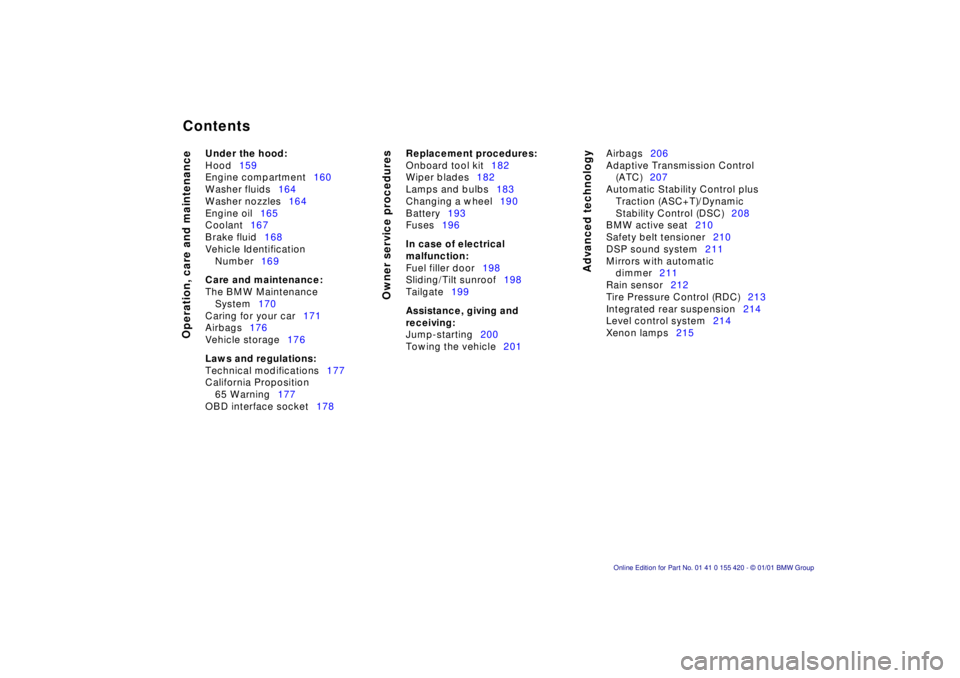
Contents
Operation, care and maintenance
Owner service procedures
Advanced technology
Under the hood:
Hood159
Engine compartment160
Washer fluids164
Washer nozzles164
Engine oil165
Coolant167
Brake fluid168
Vehicle Identification
Number169
Care and maintenance:
The BMW Maintenance
System170
Caring for your car171
Airbags176
Vehicle storage176
Laws and regulations:
Technical modifications177
California Proposition
65 Warning177
OBD interface socket178
Replacement procedures:
Onboard tool kit182
Wiper blades182
Lamps and bulbs183
Changing a wheel190
Battery193
Fuses196
In case of electrical
malfunction:
Fuel filler door198
Sliding/Tilt sunroof198
Tailgate199
Assistance, giving and
receiving:
Jump-starting200
Towing the vehicle201Airbags206
Adaptive Transmission Control
(ATC)207
Automatic Stability Control plus
Traction (ASC+T)/Dynamic
Stability Control (DSC)208
BMW active seat210
Safety belt tensioner210
DSP sound system211
Mirrors with automatic
dimmer211
Rain sensor212
Tire Pressure Control (RDC)213
Integrated rear suspension214
Level control system214
Xenon lamps215
Page 29 of 238
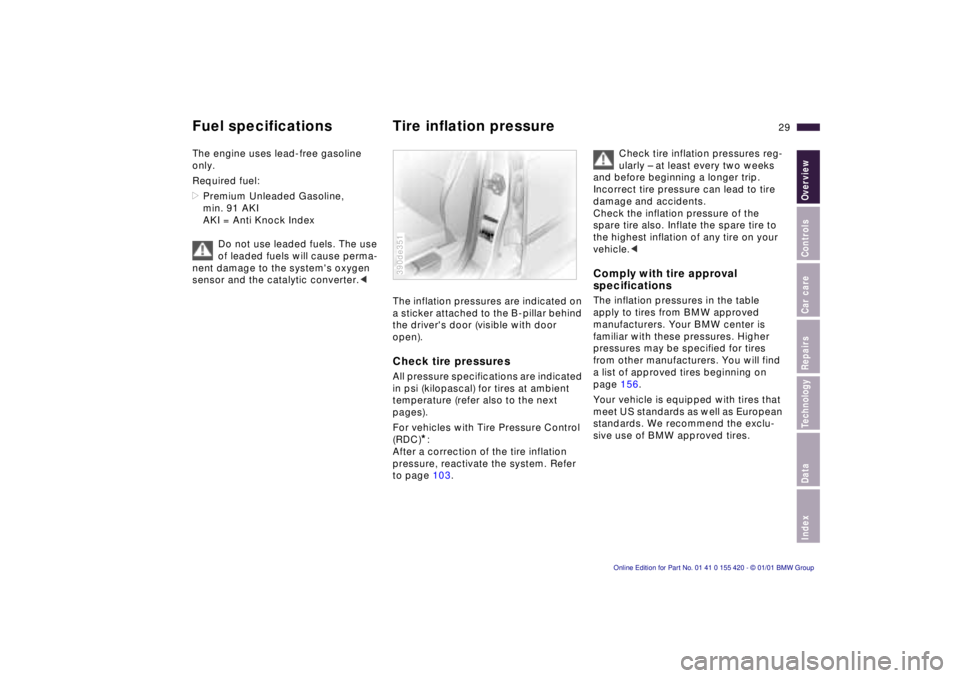
IndexDataTechnologyRepairsCar careControlsOverview
29n
Fuel specifications Tire inflation pressureThe engine uses lead-free gasoline
only.
Required fuel:
>Premium Unleaded Gasoline,
min. 91 AKI
AKI = Anti Knock Index
Do not use leaded fuels. The use
of leaded fuels will cause perma-
nent damage to the system's oxygen
sensor and the catalytic converter.<
The inflation pressures are indicated on
a sticker attached to the B-pillar behind
the driver's door (visible with door
open).Check tire pressuresAll pressure specifications are indicated
in psi (kilopascal) for tires at ambient
temperature (refer also to the next
pages).
For vehicles with Tire Pressure Control
(RDC)
*:
After a correction of the tire inflation
pressure, reactivate the system. Refer
to page 103.
390de351
Check tire inflation pressures reg-
ularly – at least every two weeks
and before beginning a longer trip.
Incorrect tire pressure can lead to tire
damage and accidents.
Check the inflation pressure of the
spare tire also. Inflate the spare tire to
the highest inflation of any tire on your
vehicle.<
Comply with tire approval
specificationsThe inflation pressures in the table
apply to tires from BMW approved
manufacturers. Your BMW center is
familiar with these pressures. Higher
pressures may be specified for tires
from other manufacturers. You will find
a list of approved tires beginning on
page 156.
Your vehicle is equipped with tires that
meet US standards as well as European
standards. We recommend the exclu-
sive use of BMW approved tires.
Page 40 of 238
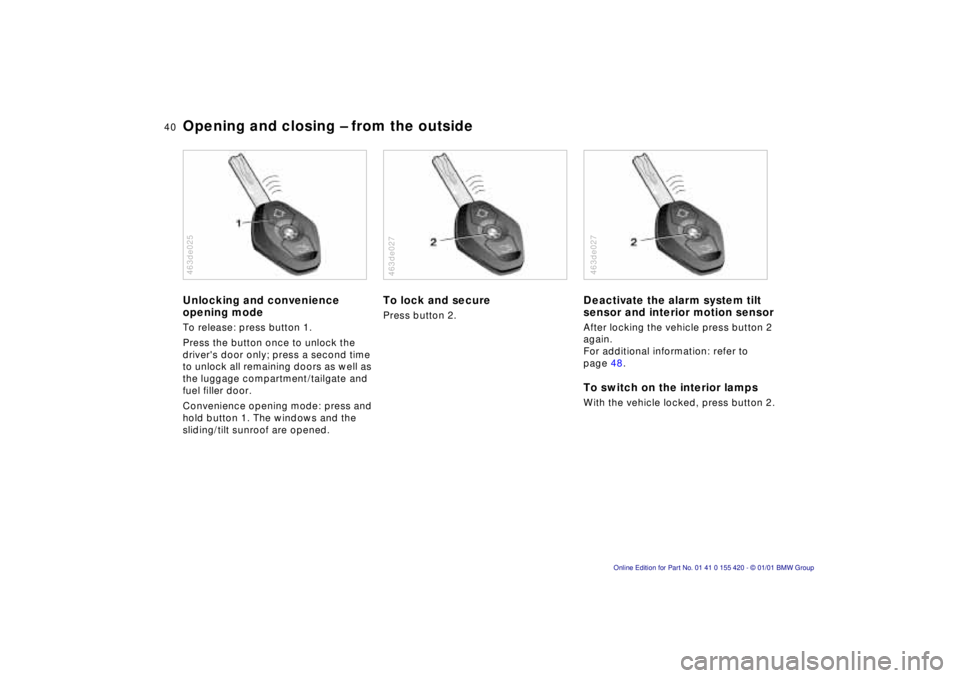
40n
Opening and closing – from the outsideUnlocking and convenience
opening modeTo release: press button 1.
Press the button once to unlock the
driver's door only; press a second time
to unlock all remaining doors as well as
the luggage compartment/tailgate and
fuel filler door.
Convenience opening mode: press and
hold button 1. The windows and the
sliding/tilt sunroof are opened.463de025
To lock and securePress button 2.463de027
Deactivate the alarm system tilt
sensor and interior motion sensorAfter locking the vehicle press button 2
again.
For additional information: refer to
page 48.To switch on the interior lampsWith the vehicle locked, press button 2.380us646463de027
Page 47 of 238
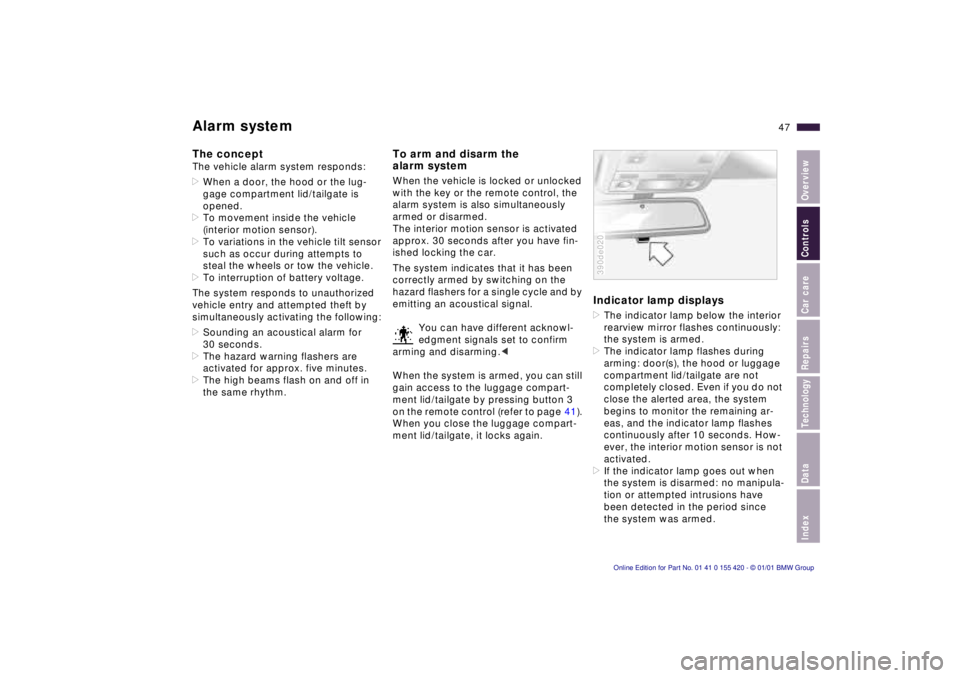
IndexDataTechnologyRepairsCar careControlsOverview
47n
Alarm systemThe conceptThe vehicle alarm system responds:
>When a door, the hood or the lug-
gage compartment lid/tailgate is
opened.
>To movement inside the vehicle
(interior motion sensor).
>To variations in the vehicle tilt sensor
such as occur during attempts to
steal the wheels or tow the vehicle.
>To interruption of battery voltage.
The system responds to unauthorized
vehicle entry and attempted theft by
simultaneously activating the following:
>Sounding an acoustical alarm for
30 seconds.
>The hazard warning flashers are
activated for approx. five minutes.
>The high beams flash on and off in
the same rhythm.
To arm and disarm the
alarm systemWhen the vehicle is locked or unlocked
with the key or the remote control, the
alarm system is also simultaneously
armed or disarmed.
The interior motion sensor is activated
approx. 30 seconds after you have fin-
ished locking the car.
The system indicates that it has been
correctly armed by switching on the
hazard flashers for a single cycle and by
emitting an acoustical signal.
You can have different acknowl-
edgment signals set to confirm
arming and disarming.<
When the system is armed, you can still
gain access to the luggage compart-
ment lid/tailgate by pressing button 3
on the remote control (refer to page 41).
When you close the luggage compart-
ment lid/tailgate, it locks again.
Indicator lamp displays>The indicator lamp below the interior
rearview mirror flashes continuously:
the system is armed.
>The indicator lamp flashes during
arming: door(s), the hood or luggage
compartment lid/tailgate are not
completely closed. Even if you do not
close the alerted area, the system
begins to monitor the remaining ar-
eas, and the indicator lamp flashes
continuously after 10 seconds. How-
ever, the interior motion sensor is not
activated.
>If the indicator lamp goes out when
the system is disarmed: no manipula-
tion or attempted intrusions have
been detected in the period since
the system was armed.390de020
Page 48 of 238
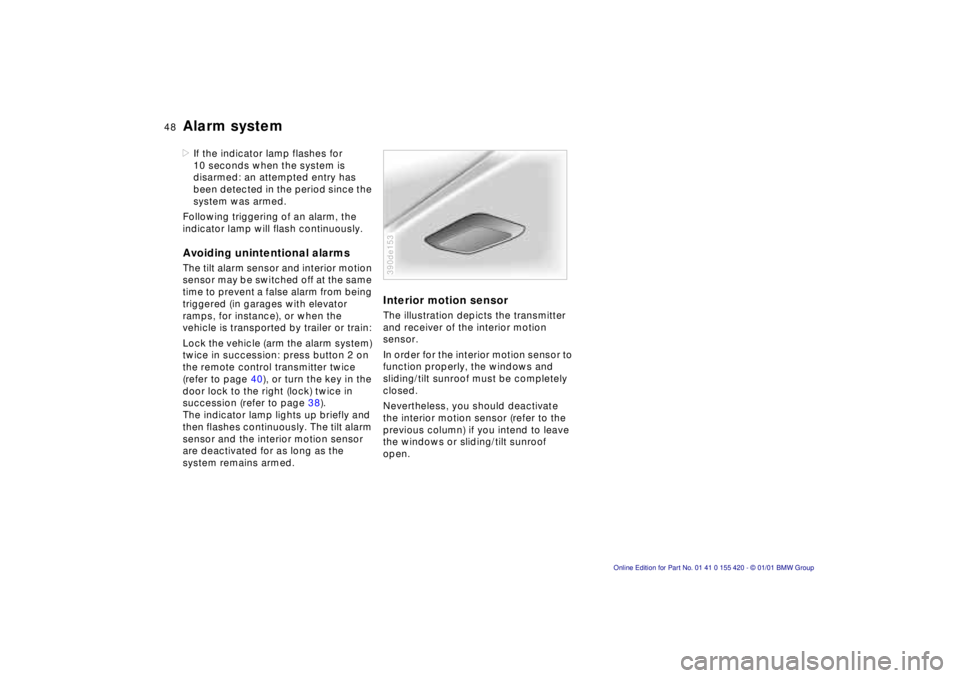
48n
Alarm system>If the indicator lamp flashes for
10 seconds when the system is
disarmed: an attempted entry has
been detected in the period since the
system was armed.
Following triggering of an alarm, the
indicator lamp will flash continuously.Avoiding unintentional alarmsThe tilt alarm sensor and interior motion
sensor may be switched off at the same
time to prevent a false alarm from being
triggered (in garages with elevator
ramps, for instance), or when the
vehicle is transported by trailer or train:
Lock the vehicle (arm the alarm system)
twice in succession: press button 2 on
the remote control transmitter twice
(refer to page 40), or turn the key in the
door lock to the right (lock) twice in
succession (refer to page 38).
The indicator lamp lights up briefly and
then flashes continuously. The tilt alarm
sensor and the interior motion sensor
are deactivated for as long as the
system remains armed.
Interior motion sensorThe illustration depicts the transmitter
and receiver of the interior motion
sensor.
In order for the interior motion sensor to
function properly, the windows and
sliding/tilt sunroof must be completely
closed.
Nevertheless, you should deactivate
the interior motion sensor (refer to the
previous column) if you intend to leave
the windows or sliding/tilt sunroof
open.390de153
Page 78 of 238
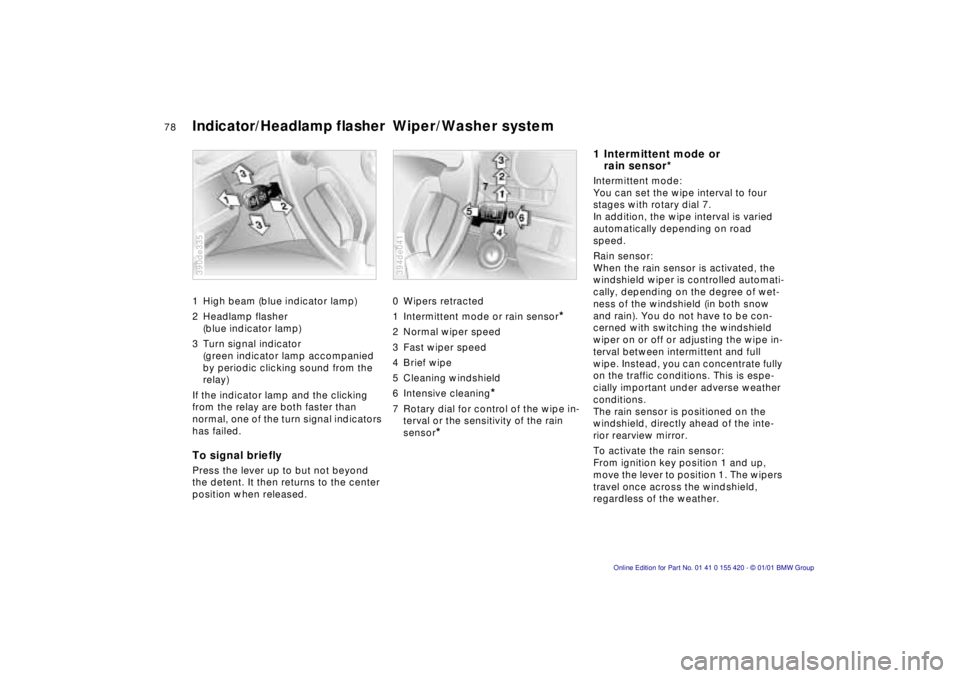
78n
Indicator/Headlamp flasher Wiper/Washer system1 High beam (blue indicator lamp)
2 Headlamp flasher
(blue indicator lamp)
3 Turn signal indicator
(green indicator lamp accompanied
by periodic clicking sound from the
relay)
If the indicator lamp and the clicking
from the relay are both faster than
normal, one of the turn signal indicators
has failed.To signal brieflyPress the lever up to but not beyond
the detent. It then returns to the center
position when released.390de335
0 Wipers retracted
1 Intermittent mode or rain sensor
*
2 Normal wiper speed
3 Fast wiper speed
4 Brief wipe
5 Cleaning windshield
6 Intensive cleaning
*
7 Rotary dial for control of the wipe in-
terval or the sensitivity of the rain
sensor
*
394de041
1 Intermittent mode or
rain sensor*Intermittent mode:
You can set the wipe interval to four
stages with rotary dial 7.
In addition, the wipe interval is varied
automatically depending on road
speed.
Rain sensor:
When the rain sensor is activated, the
windshield wiper is controlled automati-
cally, depending on the degree of wet-
ness of the windshield (in both snow
and rain). You do not have to be con-
cerned with switching the windshield
wiper on or off or adjusting the wipe in-
terval between intermittent and full
wipe. Instead, you can concentrate fully
on the traffic conditions. This is espe-
cially important under adverse weather
conditions.
The rain sensor is positioned on the
windshield, directly ahead of the inte-
rior rearview mirror.
To activate the rain sensor:
From ignition key position 1 and up,
move the lever to position 1. The wipers
travel once across the windshield,
regardless of the weather.
Page 79 of 238
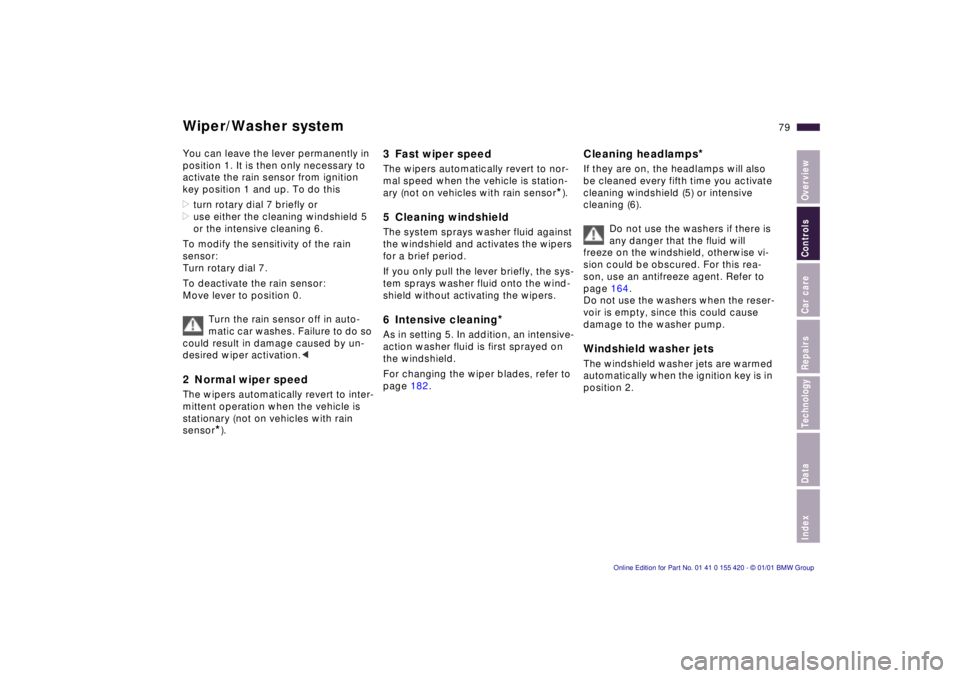
IndexDataTechnologyRepairsCar careControlsOverview
79n
Wiper/Washer systemYou can leave the lever permanently in
position 1. It is then only necessary to
activate the rain sensor from ignition
key position 1 and up. To do this
>turn rotary dial 7 briefly or
>use either the cleaning windshield 5
or the intensive cleaning 6.
To modify the sensitivity of the rain
sensor:
Turn rotary dial 7.
To deactivate the rain sensor:
Move lever to position 0.
Turn the rain sensor off in auto-
matic car washes. Failure to do so
could result in damage caused by un-
desired wiper activation.< 2 Normal wiper speedThe wipers automatically revert to inter-
mittent operation when the vehicle is
stationary (not on vehicles with rain
sensor
*).
3 Fast wiper speedThe wipers automatically revert to nor-
mal speed when the vehicle is station-
ary (not on vehicles with rain sensor
*).
5 Cleaning windshieldThe system sprays washer fluid against
the windshield and activates the wipers
for a brief period.
If you only pull the lever briefly, the sys-
tem sprays washer fluid onto the wind-
shield without activating the wipers.6 Intensive cleaning
*
As in setting 5. In addition, an intensive-
action washer fluid is first sprayed on
the windshield.
For changing the wiper blades, refer to
page 182.
Cleaning headlamps
*
If they are on, the headlamps will also
be cleaned every fifth time you activate
cleaning windshield (5) or intensive
cleaning (6).
Do not use the washers if there is
any danger that the fluid will
freeze on the windshield, otherwise vi-
sion could be obscured. For this rea-
son, use an antifreeze agent. Refer to
page 164.
Do not use the washers when the reser-
voir is empty, since this could cause
damage to the washer pump. Windshield washer jetsThe windshield washer jets are warmed
automatically when the ignition key is in
position 2.
Page 100 of 238
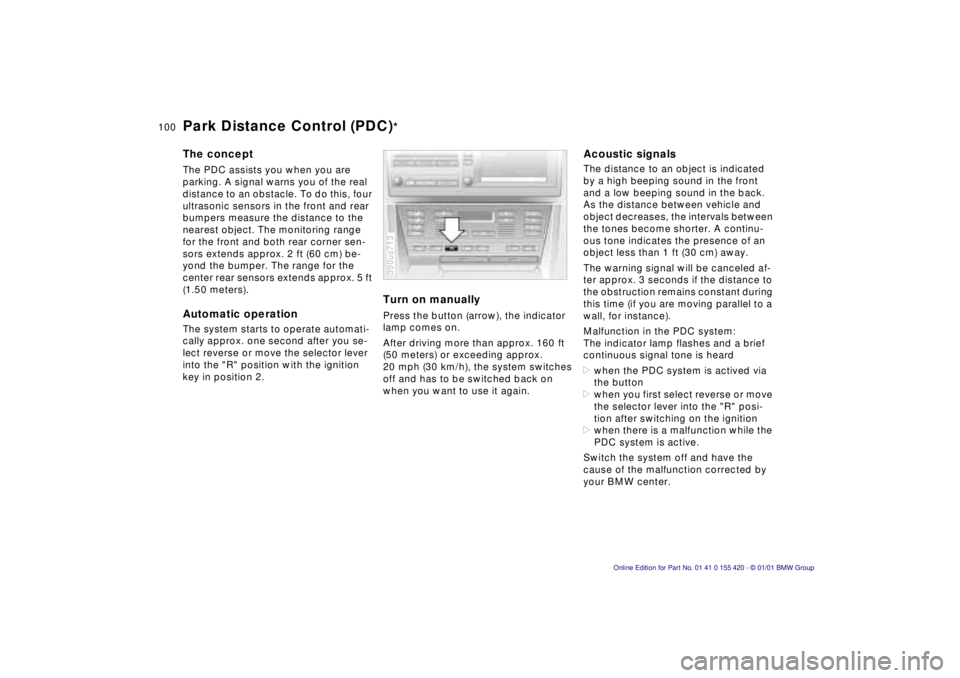
100n
The conceptThe PDC assists you when you are
parking. A signal warns you of the real
distance to an obstacle. To do this, four
ultrasonic sensors in the front and rear
bumpers measure the distance to the
nearest object. The monitoring range
for the front and both rear corner sen-
sors extends approx. 2 ft (60 cm) be-
yond the bumper. The range for the
center rear sensors extends approx. 5 ft
(1.50 meters).Automatic operationThe system starts to operate automati-
cally approx. one second after you se-
lect reverse or move the selector lever
into the "R" position with the ignition
key in position 2.
Turn on manuallyPress the button (arrow), the indicator
lamp comes on.
After driving more than approx. 160 ft
(50 meters) or exceeding approx.
20 mph (30 km/h), the system switches
off and has to be switched back on
when you want to use it again.390us713
Acoustic signalsThe distance to an object is indicated
by a high beeping sound in the front
and a low beeping sound in the back.
As the distance between vehicle and
object decreases, the intervals between
the tones become shorter. A continu-
ous tone indicates the presence of an
object less than 1 ft (30 cm) away.
The warning signal will be canceled af-
ter approx. 3 seconds if the distance to
the obstruction remains constant during
this time (if you are moving parallel to a
wall, for instance).
Malfunction in the PDC system:
The indicator lamp flashes and a brief
continuous signal tone is heard
>when the PDC system is actived via
the button
>when you first select reverse or move
the selector lever into the "R" posi-
tion after switching on the ignition
>when there is a malfunction while the
PDC system is active.
Switch the system off and have the
cause of the malfunction corrected by
your BMW center.
Park Distance Control (PDC)
*